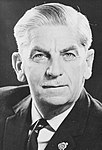An election was held on 21 November 1970 to elect 32 of the 60 seats in the Australian Senate. This is the most recent occasion on which a Senate election has been held with no accompanying election to the House of Representatives; the two election cycles had been out of synchronisation since 1963.
| |||||||||||||||||||||||||||||||||||||||||
32 of the 60 seats in the Senate 16 seats needed for a majority | |||||||||||||||||||||||||||||||||||||||||
|---|---|---|---|---|---|---|---|---|---|---|---|---|---|---|---|---|---|---|---|---|---|---|---|---|---|---|---|---|---|---|---|---|---|---|---|---|---|---|---|---|---|
| |||||||||||||||||||||||||||||||||||||||||
Key dates
edit| Date | Event |
|---|---|
| 16 October 1970 | Writs were issued by the respective State Governors to proceed with an election.[1][2][3] |
| 29 October 1970 | Close of nominations, at 12pm. |
| 21 November 1970 | Polling day, between the hours of 8am and 6pm. |
| 17 December 1970 | Declaration of the poll for South Australia.[4] |
| 7 January 1971 | Return of the writs. |
Results
editThe governing Coalition and the opposition Australian Labor Party won 13 and 14 seats respectively, resulting in a total of 26 seats each, while the Democratic Labor Party and three independents (two newly elected) held the remaining seats.
| Party | Votes | % | Swing | Seats won | Seats held | Change | ||
|---|---|---|---|---|---|---|---|---|
| Labor | 2,376,215 | 42.22 | –2.81 | 14 | 26 | –1 | ||
| Liberal–Country coalition (total) | 2,149,023 | 38.18 | –4.59 | 13 | 26 | –2 | ||
| Liberal–Country joint ticket | 1,098,134 | 19.51 | –14.31 | 4 | * | * | ||
| Liberal | 991,473 | 17.61 | +9.47 | 8 | 21 | 0 | ||
| Country | 59,416 | 1.06 | +0.24 | 1 | 5 | –2 | ||
| Democratic Labor | 625,142 | 11.11 | +1.34 | 3 | 5 | +1 | ||
| Australia | 163,343 | 2.90 | +2.90 | 0 | 0 | 0 | ||
| Better Education Committee | 59,813 | 1.06 | +1.06 | 0 | 0 | 0 | ||
| Democratic | 52,799 | 0.94 | +0.94 | 0 | 0 | 0 | ||
| Pensioner Power | 28,983 | 0.51 | +0.51 | 0 | 0 | 0 | ||
| Defence of Government Schools | 27,796 | 0.49 | +0.49 | 0 | 0 | 0 | ||
| National Socialist | 24,017 | 0.43 | +0.43 | 0 | 0 | 0 | ||
| Conservative Immigration Movement | 4,864 | 0.08 | +0.08 | 0 | 0 | 0 | ||
| Independent | 116,838 | 2.07 | +0.37 | 2 | 3 | +2 | ||
| Total | 5,628,833 | 32 | 60 | |||||
- Notes
- In New South Wales and Queensland, the coalition parties ran a joint ticket. Of the four senators elected on a joint ticket, three were members of the Liberal Party and one was a member of the Country Party. In Western Australia, the coalition parties ran on separate tickets. In South Australia, Tasmania, and Victoria, only the Liberal Party ran a ticket.
- Two independents were elected – Michael Townley of Tasmania and Syd Negus of Western Australia. This brought the total number of independents in the Senate to three, the other being Reg Turnbull of Tasmania.[5]
See also
editReferences
edit- ^ * "Election of Senators Act, 1903. Proclamation" (PDF). Western Australia Government Gazette. 7 October 1970. p. 3117.
- ^ "Senate Elections Act 1958 (No. 6365) (per 9145/70)". Victoria Government Gazette. Victorian Government Printer. 7 October 1970. p. 3309.
- ^ "Senators' Elections Act 1903: Order under Section 3 (136)". Government Gazette of the State of New South Wales. 14 October 1970. p. 4142. Retrieved 10 October 2020.
- ^ "Election of Senators for the State of South Australia (Proclamation) (44)" (PDF). South Australian Government Gazette. Government of South Australia. 6 October 1970. p. 1501. Retrieved 10 October 2020.
- ^ Parliamentary Handbook – Members of the Senate since 1901 Archived 25 July 2008 at the Wayback Machine
External links
edit- University of WA Archived 18 January 2015 at the Wayback Machine election results in Australia since 1890


